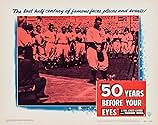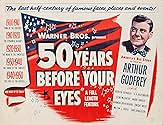Adicionar um enredo no seu idiomaDocumentary about the major events of the first fifty years of the Twentieth Century.Documentary about the major events of the first fifty years of the Twentieth Century.Documentary about the major events of the first fifty years of the Twentieth Century.
- Direção
- Roteiristas
- Artistas
Enrico Caruso
- Self
- (cenas de arquivo)
Charles Chaplin
- Self
- (cenas de arquivo)
King Charles III
- Self
- (cenas de arquivo)
- (as Prince Charles)
Buffalo Bill Cody
- Self
- (cenas de arquivo)
- (as William F. Cody)
Calvin Coolidge
- Self
- (cenas de arquivo)
Eugene V. Debs
- Self
- (cenas de arquivo)
Gertrude Ederle
- Self
- (cenas de arquivo)
Dwight D. Eisenhower
- Self
- (cenas de arquivo)
Mohandas K. Gandhi
- Self
- (cenas de arquivo)
- (as Mahatma Gandhi)
- Direção
- Roteiristas
- Elenco e equipe completos
- Produção, bilheteria e muito mais no IMDbPro
Avaliações em destaque
It might seem pointless to describe this film, other that to state the obvious. It is a compilation of major American and world news events from 1900 to 1950. Obviously with a run time of only 72 minutes, the film mostly includes only the tips of the biggest icebergs.
However, what I believe are useful to comment on are 1) the spin of the accompanying narration, and 2) some stories that seem major now but were omitted.
The film is so pro-American and patriotic, one might consider it propaganda. The film begins with America the Beautiful and ends with the Star Spangled Banner. The voiceover says Americans were `aided by God,' would `make the world safe for democracy,' and led `the worldwide fight against tyranny.' Also `Our country springs from the principle of righteousness,' `Others look to us for leadership,' and `Americans are firm in their right as God helps us to see the right.' Communists are referred to everywhere as `Reds' (`the exact opposite of freedom'). Japanese are referred to as `Japs' (`Americans fought Jap-by-Jap' in the Pacific WW2 campaign). The film is condescending toward women in a couple of places (`Women are, after all, still women').
There is no mention of the Holocaust (!) or U.S. internment camps for Japanese-Americans. There is virtually no coverage of civil rights, other than Jesse Owens and Joe Lewis as `breakthrough athletes,' and (appropriately) disparaging remarks about a Ku Klux Klan march in Washington.
Nevertheless, I don't regard these `faults' as reasons to avoid the film. They may actually say a lot about the attitude of many Americans (or at least the media) circa 1950.
This film is a worthwhile history lesson squeezed into a short space.
I reviewed this movie as part of a project at the Library of Congress. I've named the project FIFTY: 50 Notable Films Forgotten Within 50 Years. As best I can determine, this film, like the other forty-nine I've identified, has not been on video, telecast, or distributed in the U.S. since its original release. In my opinion, it is worthy of being made available again.
However, what I believe are useful to comment on are 1) the spin of the accompanying narration, and 2) some stories that seem major now but were omitted.
The film is so pro-American and patriotic, one might consider it propaganda. The film begins with America the Beautiful and ends with the Star Spangled Banner. The voiceover says Americans were `aided by God,' would `make the world safe for democracy,' and led `the worldwide fight against tyranny.' Also `Our country springs from the principle of righteousness,' `Others look to us for leadership,' and `Americans are firm in their right as God helps us to see the right.' Communists are referred to everywhere as `Reds' (`the exact opposite of freedom'). Japanese are referred to as `Japs' (`Americans fought Jap-by-Jap' in the Pacific WW2 campaign). The film is condescending toward women in a couple of places (`Women are, after all, still women').
There is no mention of the Holocaust (!) or U.S. internment camps for Japanese-Americans. There is virtually no coverage of civil rights, other than Jesse Owens and Joe Lewis as `breakthrough athletes,' and (appropriately) disparaging remarks about a Ku Klux Klan march in Washington.
Nevertheless, I don't regard these `faults' as reasons to avoid the film. They may actually say a lot about the attitude of many Americans (or at least the media) circa 1950.
This film is a worthwhile history lesson squeezed into a short space.
I reviewed this movie as part of a project at the Library of Congress. I've named the project FIFTY: 50 Notable Films Forgotten Within 50 Years. As best I can determine, this film, like the other forty-nine I've identified, has not been on video, telecast, or distributed in the U.S. since its original release. In my opinion, it is worthy of being made available again.
Você sabia?
- CuriosidadesAccording to a 7 May 1950 New York Times article, the film took three years to compile.
Principais escolhas
Faça login para avaliar e ver a lista de recomendações personalizadas
Detalhes
- Data de lançamento
- País de origem
- Central de atendimento oficial
- Idioma
- Também conhecido como
- Myrskyisä 1900-luku
- Empresa de produção
- Consulte mais créditos da empresa na IMDbPro
- Tempo de duração1 hora 12 minutos
- Cor
- Proporção
- 1.37 : 1
Contribua para esta página
Sugerir uma alteração ou adicionar conteúdo ausente

Principal brecha
By what name was Fifty Years Before Your Eyes (1950) officially released in Canada in English?
Responda













